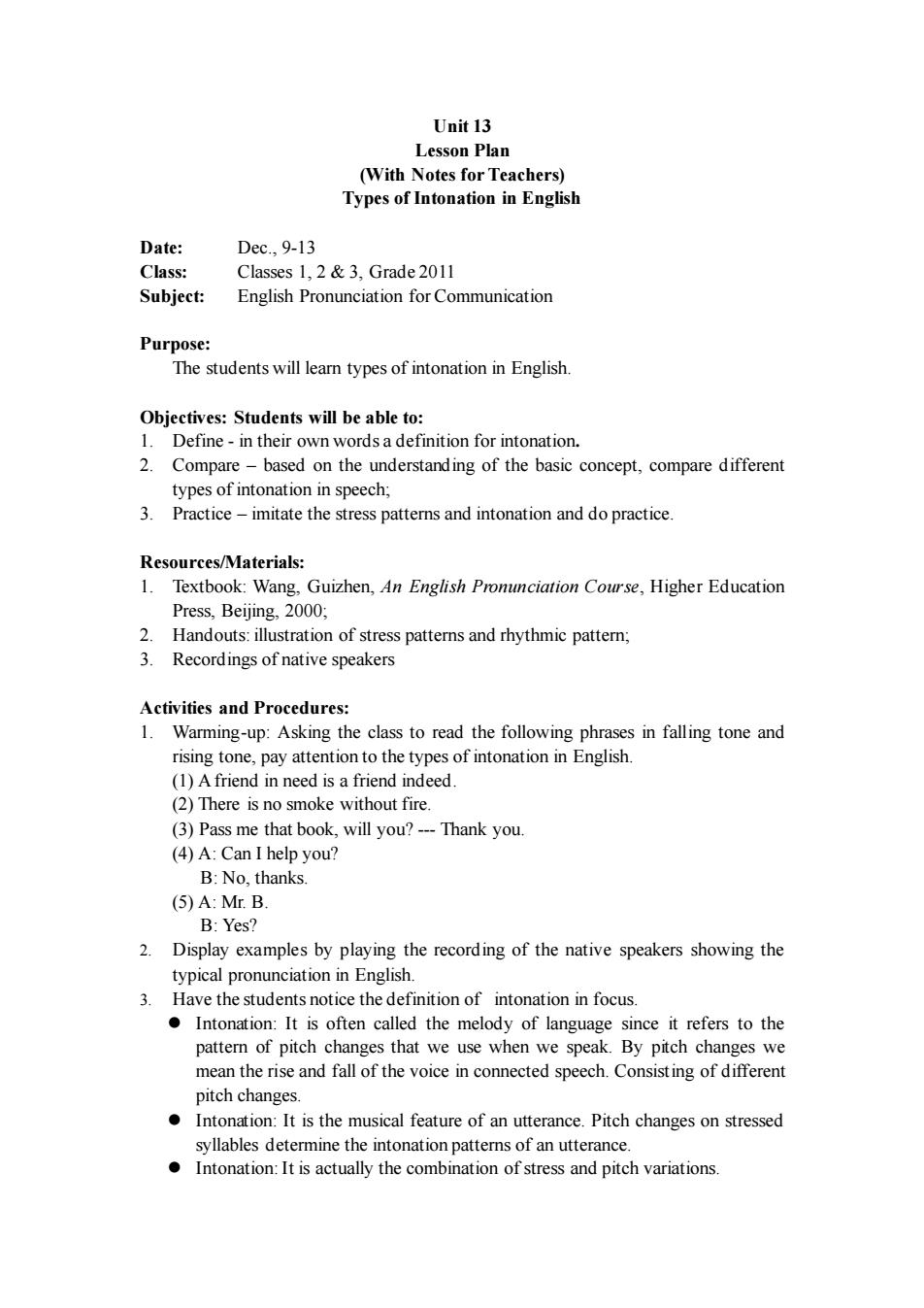正在加载图片...

Unit 13 Lesson Plan (With Notes for Teachers) Types of Intonation in English Dates Dec.9.13 Class Cla ses 1,2&3,Grade 2011 Subject: English Pronunciation for Communication Purpose: The students will learn types of intonation in English. Objectives:Students will be able to: Define-in their own words a definition for intonation. 2.Compare-based on the understanding of the basic concept,compare different types of intonation in speech: Practice-imitate the stress patters and intonation and do practice. Resources/Materials: 1.Textbook:Wang,Guizhen,An English Pronunciation Course,Higher Education Press,Beijing,2000; 2.Handouts:illustration of stress patters and rhythmic pattem; Recordings of native speakers Activities and Procedures: 1.Warming-up:Asking the class to read the following phrases in falling tone and rising tone,pay attention to the types of intonation in English. (1)Afriend in need is a friend indeed. (2)There is n smoke withou fire (3)Pass me that book,will you?-Thank you (4)A:Can I help you? B:No,thanks. (5)A:Mr.B. B.Yes? 2.Display examples by playing the recording of the native speakers showing the typical pronunciation in English. 3.Have the students notice the definition of intonation in focus. Intonation:It is often called the melody of language since it refers to the pattem of pitch ch s that he pach ch k.By nge mean the rise and fall of the voice in connected speech.Consisting of different pitch changes. Intonation:It is the musical feature of an utterance.Pitch changes on stressed syllables determine the intonation patterns of an utterance. Intonation:It is actually the combination ofstress and pitch variationsUnit 13 Lesson Plan (With Notes for Teachers) Types of Intonation in English Date: Dec., 9-13 Class: Classes 1, 2 & 3, Grade 2011 Subject: English Pronunciation for Communication Purpose: The students will learn types of intonation in English. Objectives: Students will be able to: 1. Define - in their own words a definition for intonation. 2. Compare – based on the understanding of the basic concept, compare different types of intonation in speech; 3. Practice – imitate the stress patterns and intonation and do practice. Resources/Materials: 1. Textbook: Wang, Guizhen, An English Pronunciation Course, Higher Education Press, Beijing, 2000; 2. Handouts: illustration of stress patterns and rhythmic pattern; 3. Recordings of native speakers Activities and Procedures: 1. Warming-up: Asking the class to read the following phrases in falling tone and rising tone, pay attention to the types of intonation in English. (1) A friend in need is a friend indeed. (2) There is no smoke without fire. (3) Pass me that book, will you? - Thank you. (4) A: Can I help you? B: No, thanks. (5) A: Mr. B. B: Yes? 2. Display examples by playing the recording of the native speakers showing the typical pronunciation in English. 3. Have the students notice the definition of intonation in focus. ⚫ Intonation: It is often called the melody of language since it refers to the pattern of pitch changes that we use when we speak. By pitch changes we mean the rise and fall of the voice in connected speech. Consisting of different pitch changes. ⚫ Intonation: It is the musical feature of an utterance. Pitch changes on stressed syllables determine the intonation patterns of an utterance. ⚫ Intonation: It is actually the combination of stress and pitch variations